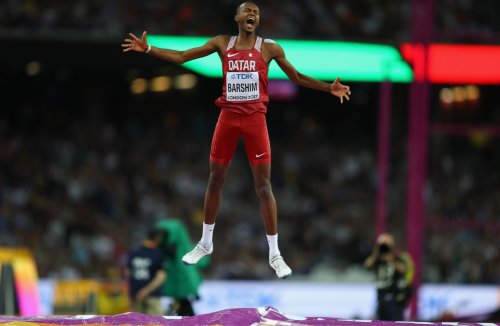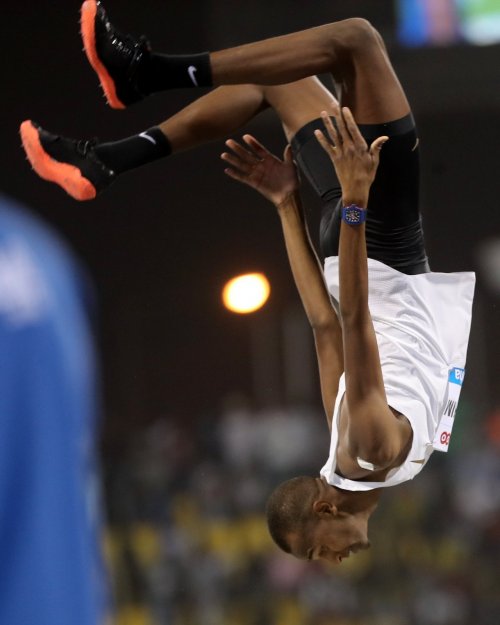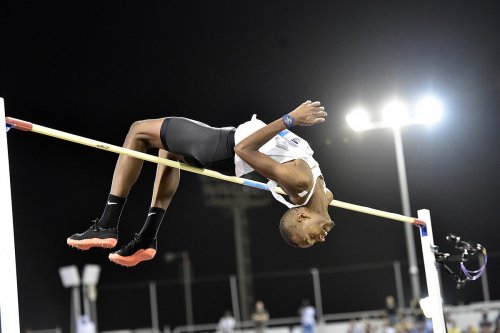 Mutaz Barshim jumps for joy after the London 2017 World Championships, photo by Qatar Olympic Committee
Mutaz Barshim jumps for joy after the London 2017 World Championships, photo by Qatar Olympic Committee
This is the first in a series on the high jump, by Stuart Weir.
High Jumping
Most of my posts on RunBlogRun have been on track but today I am starting a little series on the High Jump, one of the more technical events in our sport.
According to Greatest Sporting Nation, the first recorded high jump event took place in Scotland in the 19th century. In the early days jumpers used a straight-on approach or a scissors technique. Techniques evolved through the Eastern cut-off, the Western roll and the straddle until Dick Fosbury changed everything. More about Mr Fosbury later, when he gets a post to himself!
High Jump was in the first modern Olympics in Greece in 1896 with Ellery Clark (a student at Harvard) winning with 1.81m. High Jump for women was introduced to the Olympics in 1928 when Ethel Catherwood of Canada won with 1.59m. Heights have moved on with Derek Drouin winning the Olympics in Rio with 2.38 while women routinely clear 2m.
At one level high jump is simple – you jump over a bar and the person who clears the highest bar wins. There is, however, a bit of strategy involved. The meet sets the progression of heights and the athlete has to decide when to enter the competition and whether to jump every height. If you come in too late and fail to clear the , the competition is over. Come in too early and you waste energy.
In a championship it is not unusual for the completion to end in a tie, with more than one athlete jumping the top height. At the Olympics in 2016 four ladies “tied” at 1.97 (with eight below them jumping 1.93). Places are awarded according to the number of previous failures. The winner is:
1 The person with the fewest misses at the last cleared height. If that does not separate athletes…2 The person with the fewest misses overall in the competition.
That has not always been in the system with jump-offs sometimes used. A later article on Dorothy Tyler, 1936 and 1948 Olympic silver medallist, will show Tyler to be arguably the unluckiest high jumper ever as the method of separating tied athletes changed between her two Olympics, both times to her disadvantage.
 Mutaz Barshim flips for the cheering crowd, photo courtesy Qatar Olympic Committee
Mutaz Barshim flips for the cheering crowd, photo courtesy Qatar Olympic Committee
The discipline has its characters too. Who does not enjoy watching the Italian, Gianmarco Tamberi or Qatar’s Mutah Barshim sharing their successes with the crowd?
 Mutaz Barshim high jumps in 2018 Doha Diamond League, photo courtesy Qatar Olympic Committee
Mutaz Barshim high jumps in 2018 Doha Diamond League, photo courtesy Qatar Olympic Committee
High jump in Para Athletics can be amazing particularly in the amputee class, as my previous post has shown:
2019 Dubai IPC Diary: The one-legged high jump… – RunBlogRun
High Jump is one of those disciplines which can happen in a corner of the arena, almost unnoticed. The Birmingham 2018 World Indoor Championships had a first evening session with just one race and the male and female high jump, which took place simultaneously with the two high jump bars in the middle of the arena with men and women taking alternate jumps. Men approaching from one end of the arena, women from the other. There were a few issues to be tweaked but it certainly showcased the discipline.
While most of my articles have been about running, I have had previous articles on high jump:
Nicola McDermott: How bush fires, sharks and corona cannot stop a determined high-jumper –
RunBlogRunThirteen Questions for Levern Spencer: the RunBlogRun Interview – RunBlogRun
 Mutaz Barshim smiles at the cheering crowd ater winning Doha Diamond League, photo courtesy Qatar Olympic Committee
Mutaz Barshim smiles at the cheering crowd ater winning Doha Diamond League, photo courtesy Qatar Olympic Committee
Author

Since 2015, Stuart Weir has written for RunBlogRun. He attends about 20 events a year including all most global championships and Diamond Leagues. He enjoys finding the quirky and obscure story.
View all posts

















